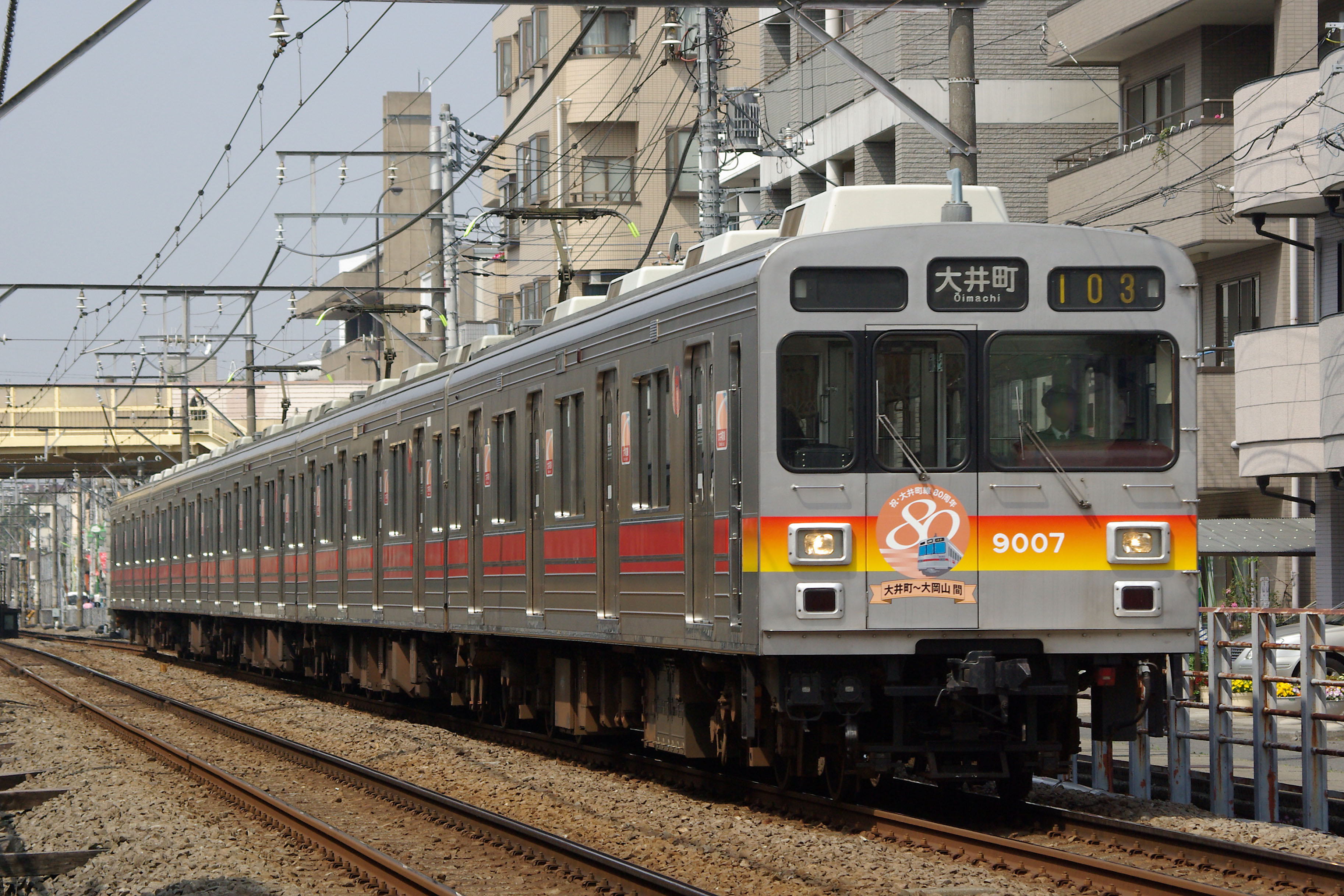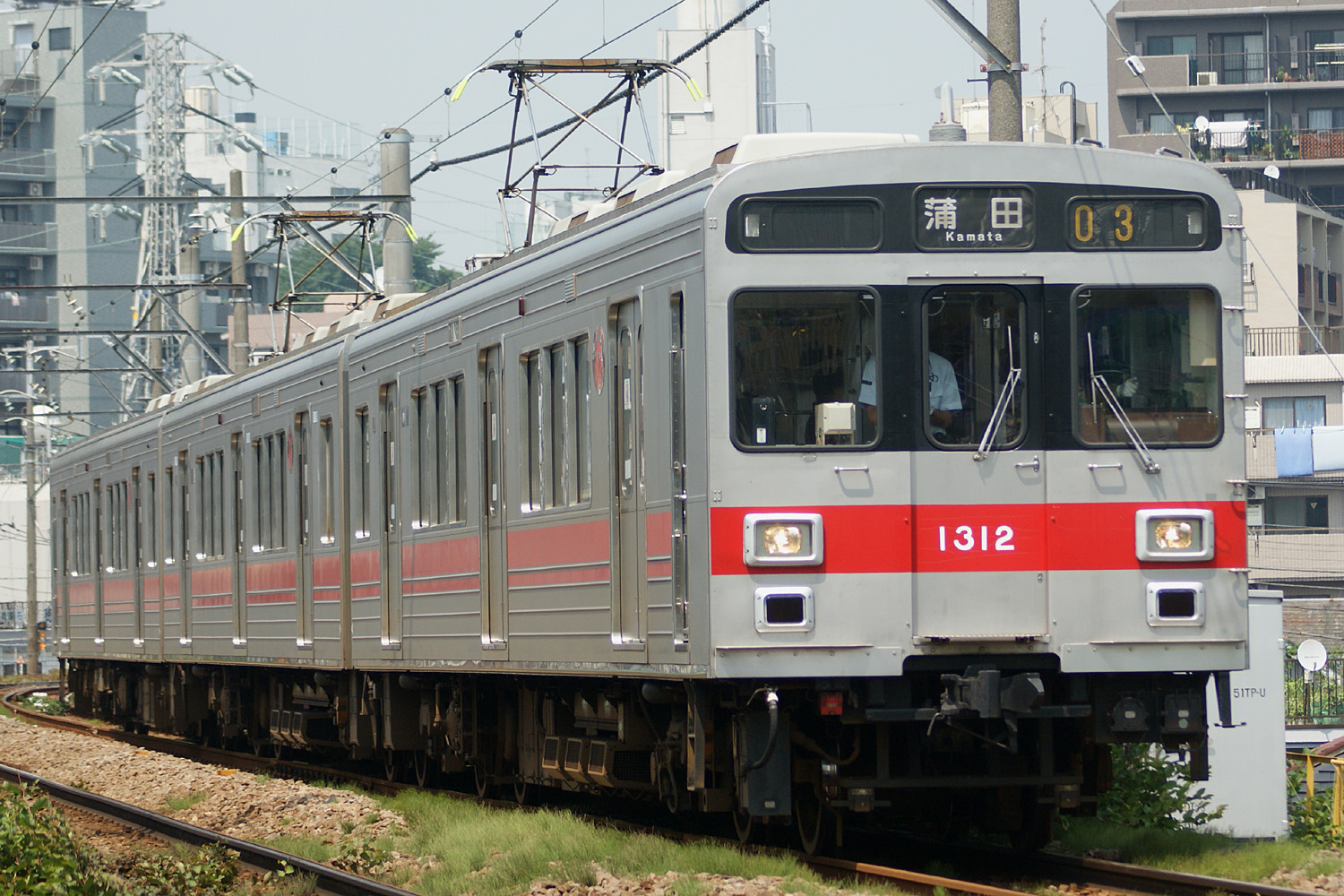|
Tokyu 9000 Series
The is a Japanese commuter electric multiple unit (EMU) train type operated by the private railway operator Tokyu Corporation in the Tokyo area of Japan. Introduced into service in March 1986, 14 eight-car sets and a five-car set were built between 1986 and 1991 by Tokyu Car Corporation for use on the Tokyu Toyoko and Oimachi lines. Between 2009 and 2013, the 9000 series sets allocated to Toyoko Line operations were transferred to the Oimachi Line. Design Cars are long, wide, and have four pairs of doors per side. While they retain the stainless steel bodies used by older Tokyu train types, they have an offset front-end door. In addition, the 9000 series was the first train type to use variable-frequency drive (more commonly referred to as VVVF) technology from new. Since its introduction in 1986, all subsequent Tokyu train types would implement the technology. The design of the 9000 series was the basis for the later Tokyu 1000 series and 2000 series train types. Fo ... [...More Info...] [...Related Items...] OR: [Wikipedia] [Google] [Baidu] |
Tokyu Car Corporation
{{Disambiguation ...
Tokyu may refer to: * Tokyu Group, a group of companies centered on Tokyu Corporation ** Tokyu Corporation, a Japanese railway company, the largest member and parent company of the group ** Tokyu Car Corporation, a former Japanese railway vehicle manufacturer, now the Japan Transport Engineering Company ** Tokyu Hands Creative Life Store, a member of the Tokyu Group ** Tokyu Department Store, a department store chain based in Japan See also * Tokyo (other) or Tokyo Metropolis is the capital of Japan. Tokyo may also refer to: Places * Edo, former name of Tokyo until 1868 *Tokyo Prefecture (1868–1943), Tokyo Prefecture, former Japanese prefecture 1868–1943 that preceded Tokyo *Tokyo City, for ... [...More Info...] [...Related Items...] OR: [Wikipedia] [Google] [Baidu] |
Private Railway
A private railway is a railroad run by a private business entity (usually a corporation but not need be), as opposed to a railroad run by a public sector. Japan In Japan, , commonly simply ''private railway'', refers to a public transit railway owned and operated by private sector, almost always organized as a joint-stock company, or in Japanese: kabushiki gaisha (lit. stock company), but may be any type of private business entity. Although the Japan Railways Group (JR Group) companies are also kabushiki gaishas, they are not classified as private railways because of their unique status as the primary successors of the Japanese National Railways (JNR). Voluntary sector railways (semi-public) are additionally not classified as ''shitetsu'' due to their origins as rural, money-losing JNR lines that have since been transferred to local possession, in spite of their organizational structures being corporatized. Among ''private railways'' in Japan, the categorizes 16 companies as "ma ... [...More Info...] [...Related Items...] OR: [Wikipedia] [Google] [Baidu] |
Electric Multiple Units Of Japan
Electricity is the set of physical phenomena associated with the presence and motion of matter that has a property of electric charge. Electricity is related to magnetism, both being part of the phenomenon of electromagnetism, as described by Maxwell's equations. Various common phenomena are related to electricity, including lightning, static electricity, electric heating, electric discharges and many others. The presence of an electric charge, which can be either positive or negative, produces an electric field. The movement of electric charges is an electric current and produces a magnetic field. When a charge is placed in a location with a non-zero electric field, a force will act on it. The magnitude of this force is given by Coulomb's law. If the charge moves, the electric field would be doing work on the electric charge. Thus we can speak of electric potential at a certain point in space, which is equal to the work done by an external agent in carrying a unit of p ... [...More Info...] [...Related Items...] OR: [Wikipedia] [Google] [Baidu] |
Tokyu 2000 Series
The , reclassified from 2019, is a Japanese commuter electric multiple unit (EMU) train type operated by Tokyu Corporation in the Tokyo area since 1992. They were used on Tokyu Den-en-toshi Line and Tokyo Metro Hanzomon Line inter-running services from 1992 until 2018, as well as the Tokyu Oimachi Line since 2018. Three 10-car sets were built by Tokyu Car Corporation between 1992 and 1993, all of which were shortened to 5-car sets by March 2019. Operations These sets are used on the Tokyu Oimachi Line. Originally, they were used on Tokyu Den-en-toshi Line and Tokyo Metro Hanzomon Line inter-running services; they were not capable of running through onto the Tobu Skytree Line, and had circular "K" stickers on the centre front cab window to indicate this. Design Based on the earlier Tokyu 9000 series EMU design, two sets were introduced in 1992, followed by a third in 1993. The first two sets were delivered with roller blind destination indicators, whereas the third set was deliv ... [...More Info...] [...Related Items...] OR: [Wikipedia] [Google] [Baidu] |
Tokyu 1000 Series
The is an electric multiple unit (EMU) train type operated by the private railway operator Tokyu Corporation on the Tokyu Ikegami and Tokyu Tamagawa lines in Japan since 1988. Design Based on the earlier Tokyu 9000 series design, the 1000 series trains were built for use on through-running services to and from the Tokyo Metro Hibiya Line. Cars are 18 metres long and have three pairs of doors per side. Operations Three-car sets have operated on the Tokyu Ikegami Line since 1993. Four-car sets formerly operated on the Tokyu Mekama Line (present-day Tokyu Tamagawa Line and Tokyu Meguro Line), and eight-car formations formerly operated on the Tokyu Toyoko Line, with through-running to and from the Tokyo Metro Hibiya Line. The former were reformed as three-car sets, and the latter were taken out of use from 15 March 2013. From May 2014, former eight-car Tokyu Toyoko Line sets were reformed into three-car sets and refurbished for use on the Tokyu Tamagawa Line and Tokyu Meguro Lin ... [...More Info...] [...Related Items...] OR: [Wikipedia] [Google] [Baidu] |
Variable-frequency Drive
A variable-frequency drive (VFD) is a type of motor drive used in electro-mechanical drive systems to control AC motor speed and torque by varying motor input frequency and, depending on topology, to control associated voltage or current variation., quote is per definition on p. 4 of NEMA Standards Publication ICS 7.2-2021. VFDs may also be known as 'AFDs' (adjustable-frequency drives), 'ASDs' (adjustable-speed drives), 'VSDs' (variable-speed drives), 'AC drives', 'micro drives', 'inverter drives' or, simply, 'drives'. VFDs are used in applications ranging from small appliances to large compressors. An increasing number of end users are showing greater interest in electric drive systems due to more stringent emission standards and demand for increased reliability and better availability. Systems using VFDs can be more efficient than those using throttling control of fluid flow, such as in systems with pumps and damper control for fans. However, the global market penetration fo ... [...More Info...] [...Related Items...] OR: [Wikipedia] [Google] [Baidu] |
Electric Multiple Unit
An electric multiple unit or EMU is a multiple-unit train consisting of self-propelled carriages using electricity as the motive power. An EMU requires no separate locomotive, as electric traction motors are incorporated within one or a number of the carriages. An EMU is usually formed of two or more semi-permanently coupled carriages, but electrically powered single-unit railcars are also generally classed as EMUs. The great majority of EMUs are passenger trains, but versions also exist for carrying mail. EMUs are popular on commuter and suburban rail networks around the world due to their fast acceleration and pollution-free operation. Being quieter than diesel multiple units (DMUs) and locomotive-hauled trains, EMUs can operate later at night and more frequently without disturbing nearby residents. In addition, tunnel design for EMU trains is simpler as no provision is needed for exhausting fumes, although retrofitting existing limited-clearance tunnels to accommodate the ... [...More Info...] [...Related Items...] OR: [Wikipedia] [Google] [Baidu] |
Tokyu Corporation
The is a Japanese multinational ''keiretsu'' ( conglomerate) holding company headquartered in Shibuya, Tokyo. Its main operation is , a wholly owned subsidiary operating railways in the Greater Tokyo Area. History The oldest predecessor of company was the , opened in 1908; the railway's operations were converted into a company in 1910. Keita Gotō, now known as a notable Japanese industrialist, was appointed as the CEO of the Musashi Electric Railway in 1920 and later he began a mass expansion program. The most important predecessor was first registered on September 2, 1922, as the and is related to the construction of Den-en-chōfu (it was originally founded by the developers of Den-en-chōfu); it was acquired by the Musashi Electric Railway in 1924, shortly before Musashi was renamed into the , also known as the Toyoko, in the same year. After Musashi/Toyoko's acquisition, the Meguro-Kamata Electric Railway initially operated as a subsidiary of Toyoko. It was not unti ... [...More Info...] [...Related Items...] OR: [Wikipedia] [Google] [Baidu] |
Pantograph (transport)
A pantograph (or "pan" or "panto") is an apparatus mounted on the roof of an electric train, tram or electric bus to collect power through contact with an overhead line. By contrast, battery electric buses and trains are charged at charging stations. The pantograph is a common type of current collector; typically, a single or double wire is used, with the return current running through the rails. The term stems from the resemblance of some styles to the mechanical pantographs used for copying handwriting and drawings. Invention The pantograph, with a low-friction, replaceable graphite contact strip or "shoe" to minimise lateral stress on the contact wire, first appeared in the late 19th century. Early versions include the bow collector, invented in 1889 by Walter Reichel, chief engineer at Siemens & Halske in Germany, and a flat slide-pantograph first used in 1895 by the Baltimore and Ohio Railroad The familiar diamond-shaped roller pantograph was devised and patented b ... [...More Info...] [...Related Items...] OR: [Wikipedia] [Google] [Baidu] |
VVVF
A variable-frequency drive (VFD) is a type of motor drive used in electro-mechanical drive systems to control AC motor speed and torque by varying motor input frequency and, depending on Topology (electrical circuits), topology, to control associated voltage or electric current, current variation., quote is per definition on p. 4 of NEMA Standards Publication ICS 7.2-2021. VFDs may also be known as 'AFDs' (adjustable-frequency drives), 'ASDs' (adjustable-speed drives), 'VSDs' (variable-speed drives), 'AC drives', 'micro drives', 'inverter drives' or, simply, 'drives'. VFDs are used in applications ranging from small appliances to large compressors. An increasing number of end users are showing greater interest in electric drive systems due to more stringent emission standards and demand for increased reliability and better availability. Systems using VFDs can be more efficient than those using throttling control of fluid flow, such as in systems with pumps and damper control f ... [...More Info...] [...Related Items...] OR: [Wikipedia] [Google] [Baidu] |






